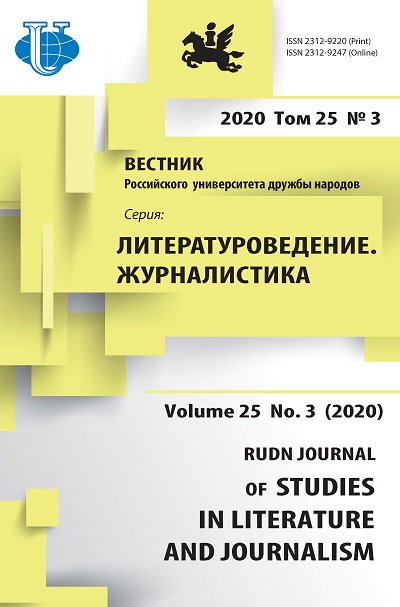Dynamic types of artistic image: Roman Ingarden’s phenomenology and literary theory
- Authors: Aksenova A.A.1
-
Affiliations:
- Kemerovo State University
- Issue: Vol 25, No 3 (2020)
- Pages: 487-496
- Section: LITERARY CRITICISM
- URL: https://journals.rudn.ru/literary-criticism/article/view/24825
- DOI: https://doi.org/10.22363/2312-9220-2020-25-3-487-496
- ID: 24825
Cite item
Full Text
Abstract
The article is devoted to the question of some data obtained by Polish philosopher Roman Ingarden, and primarily to his study of the literary work of art. Development upon Ingarden’s ideas is associated with use of Russian authors which are rarely treated in phenomenological aesthetics. The dynamic types of the image structure is that appear as potential states and actualize themselves in the reader’s reception as problem of imageability of fictional entities. Thus the dynamic character of types of an image structure is a transition from non-thematic background into its actual state and back. To study the visual in fiction, one must understand that the reader’s encounter with the literary work actualizes potential types, which, according to R. Ingarden, “sparkle and go out”. The visual nature of the aesthetic object directly depends on which of these potential states are actualized.
About the authors
Anastasia A. Aksenova
Kemerovo State University
Author for correspondence.
Email: AA9515890227@yandex.ru
Master of Philosophy, lecturer and researcher in the field of linguistics and literary studies, junior researcher of the Research and Innovation Department
6 Krasnaya St, Kemerovo, 650000, Russian FederationReferences
- Dyubo, Z.-B. (1976). Kriticheskie razmyshleniya o Poezii i Zhivopisi [Critical reflections on poetry and painting]. Moscow, Iskusstvo Publ. (In Russ.)
- Lessing, G.E. (1953). Izbrannye proizvedeniya [Selected works]. Moscow, Hudozhestvennaya literatura Publ. (In Russ.)
- Gadamer, G.G. (1991). Aktual'nost' prekrasnogo [The relevance of beauty]. Moscow, Iskusstvo Publ. (In Russ.)
- Iser, W. (2004). Izmenenie funktsii literatury. Protsess chteniia: Fenomenologicheskii podkhod [Changing the functions of the literature. Reading process: A phenomenological approach]. Sovremennaia literaturnaia teoriia [Modern literary theory]: Anthology. Moscow, Nauka Publ. (In Russ.)
- Mitscherling, J. (1985). Roman Ingarden's ‘The Literary Work of Art’: Exposition and Analyses. Philosophy and Phenomenological Research, 45(3), 351-381.
- Bahtin, M.M. (1979). Estetika slovesnogo tvorchestva [Aesthetics of verbal creativity] Moscow, Iskusstvo Publ. (In Russ.)
- Bakhtin, M.M. (1975). Voprosy literatury i estetiki. Issledovaniya raznykh let [Questions of literature and aesthetics. Studies of different years]. Moscow, Khudozhestvennaya literatura. (In Russ.)
- Asmus, V.F. (1968). Chtenie kak trud i tvorchestvo [Reading as work and creativity] Мoscow, Voprosy teorii i istorii estetiki Publ. (In Russ.)
- Fukson, L.Yu. (2007). Chtenie [Read]. Kemerovo, Kuzbassvuzizdat Publ. (In Russ.)
- Suzryukova, E.L. (2009). Suzhennoe pole videniya v hudozhestvennoj proze A.P. Chekhova [Narrowed field of vision in the artistic prose of A.P. Chekhov]. Sibirskij filologicheskij zhurnal [Siberian philological journal], (3), 42. (In Russ.)
- Lavlinskiy, S.P., & Gurovich, N.M. (2008). Vizual’noe v literature [The Visual in Literature]. Poetika: Slovar’ aktual’nykh terminov i ponyatiy [Poetics: The Dictionary of Current Terms and Concepts] (p. 37). Moscow. (In Russ.)
- Ingarden, R. (1972). Die Schicht der dargestellten Gegenständlichkeiten. Das literarische Kunstwerk: Mit einem Anhang: Von den Funktionen der Sprache im Theaterschauspiel. https://doi.org/10.1515/9783110938487.229
- Pasternak, B.L. (2010). Doctor Zhivago (R. Pevear, L. Volokhonsky, Trans.). Retrieved May 10, 2020, from http://www.rulit.me/data/programs/resources/html/Pasternak_Doctor_ Zhivago_RuLit_Net_231118.html.zip
- Olesha, Yu.K. (2017). Zavist'. Zagovor chuvstv. Strogij yunosha [Envy. The conspiracy of feelings. Strict boy]. Saint Petersburg, Vita Nova Publ. (In Russ.)
Supplementary files















